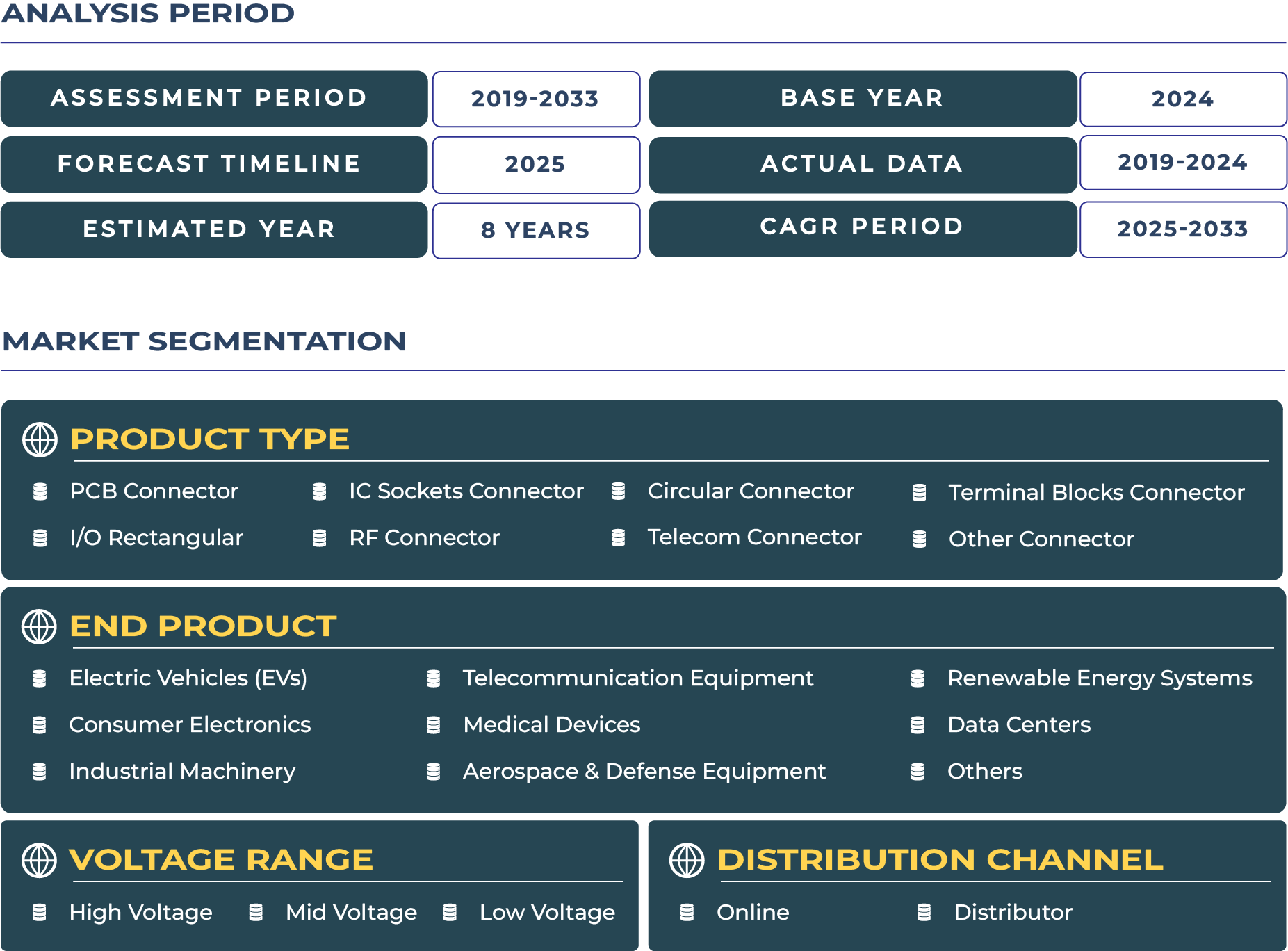Malaysia Connector Market Outlook
The Malaysia connector market is undergoing a significant transformation, driven by the nation's ambitious goals in renewable energy integration, digital infrastructure expansion, and industrial automation. According to David Gomes, Manager – Semiconductor, the market is projected to experience a compound annual growth rate (CAGR) of approximately 8.2% over the forecast period. This growth is fueled by substantial investments and policy initiatives aimed at modernizing the country's energy and digital landscapes.
Malaysia's commitment to renewable energy is evident in its plans to achieve a 70% renewable energy mix by 2050, translating into a 56GW capacity. Tenaga Nasional Berhad (TNB) is set to invest RM45 billion between 2025 and 2027 to modernize the grid, facilitating efficient integration of renewable energy sources. The "Grid of the Future" program emphasizes the deployment of Advanced Metering Infrastructure (AMI) to enable dynamic two-way energy flow and real-time monitoring. Additionally, the government's plan to deploy 100MW of battery energy storage units annually from 2030 to 2034, along with innovations in hydrogen and ammonia co-combustion projects, underscores the need for advanced connectors capable of handling high power loads and ensuring grid stability.
The data center industry in Malaysia is experiencing rapid growth, with the sector projected to increase by 78% from 2022 to 2033, outpacing Southeast Asia's average growth rate. Johor Bahru is emerging as a key data center hub, attracting investments from global tech giants like Amazon Web Services, Google, and Microsoft, who are collectively investing over $10 billion into Malaysia's data infrastructure. This expansion necessitates high-performance connectors and cable assemblies that can support high-throughput, low-latency environments, ensuring minimal signal loss and high thermal stability.
In the telecommunications sector, Malaysia's 5G network has reached 82.4% coverage of populated areas, with a second nationwide 5G license granted to enhance competition. The JENDELA plan aims to connect 9 million premises with fiber broadband by 2025, reflecting robust consumer demand. These developments require telecom-grade connectors and fiber optic solutions capable of supporting dense, high-speed data environments, particularly in urban areas.
Malaysia's push towards electric vehicle (EV) adoption, with plans for 1.5 million EVs by 2040, is redefining the cable and connector supply chain. The country is focusing on EV-ready grid enhancements, necessitating the development of high-current connectors, thermal-resistant wiring, and smart charging interfaces. These components are essential for EV powertrains, battery management systems, and the fast-charging infrastructure required to support widespread EV adoption.
The industrial sector is also a significant driver of demand for connectors, with Malaysia's strategies reflecting aspirations for regional and global competitiveness. Infrastructure projects worth RM50 billion are driving job creation, connectivity, and economic diversification. The government's holistic approach to sustainability includes initiatives like the Corporate Renewable Energy Supply Scheme (CRESS), which allows producers to negotiate tariffs directly with corporate clients, and investments in AI and digital innovation.
However, challenges such as land acquisition delays, fossil fuel subsidies, and investment misalignment pose obstacles to grid modernization. To address intermittency in renewable energy sources like solar and wind, Malaysia is prioritizing grid stability enhancements and robust infrastructure upgrades. This includes the deployment of advanced connector technologies capable of withstanding environmental extremes and ensuring reliable performance.
Leading companies actively engaged in the Malaysian connector market include Molex, TE Connectivity, and Amphenol, among others. These firms are investing in research and development to design connectors with nanomaterial coatings, modular designs for quick installation, and real-time monitoring capabilities. Such innovations are critical in meeting the evolving demands of Malaysia's rapidly expanding energy and digital infrastructure sectors.
In summary, Malaysia connector market is poised for significant growth, driven by the country's strategic investments in renewable energy, digital infrastructure, and industrial automation. The integration of advanced connector technologies will be instrumental in achieving Malaysia's long-term goals of sustainability, economic diversification, and regional competitiveness.
Authors: David Gomes (Manager – Semiconductor)
*Research Methodology: This report is based on DataCube’s proprietary 3-stage forecasting model, combining primary research, secondary data triangulation, and expert validation. [Learn more]
Malaysia Connector Market Scope







